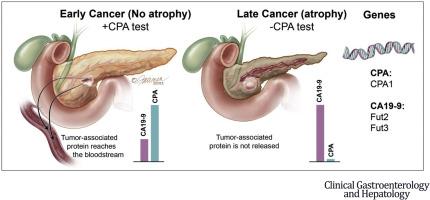Clinical Gastroenterology and Hepatology ( IF 11.6 ) Pub Date : 2021-10-12 , DOI: 10.1016/j.cgh.2021.10.008 Haruyoshi Tanaka 1 , Koji Tamura 1 , Toshiya Abe 1 , Takeichi Yoshida 1 , Anne Macgregor-Das 1 , Mohamad Dbouk 1 , Amanda L Blackford 2 , Michael Borges 3 , Anne Marie Lennon 4 , Jin He 3 , Richard Burkhart 3 , Marcia Irene Canto 5 , Michael Goggins 6

|
Background and Aims
Serum diagnostic markers of early-stage pancreatic ductal adenocarcinoma (PDAC) are needed, especially for stage I disease. As tumors grow and cause pancreatic atrophy, markers derived from pancreatic parenchyma such as serum carboxypeptidase A (CPA) activity lose diagnostic performance. We evaluated, with CA19-9, serum CPA as a marker of early pancreatic cancer.
Methods
Serum CPA activity levels were measured in 345 controls undergoing pancreatic surveillance, divided into 2 sets, set 1 being used to establish a reference range. Variants within the CPA1 locus were sought for their association with pancreatic CPA1 expression to determine if such variants associated with serum CPA levels. A total of 190 patients with resectable PDAC were evaluated.
Results
Among controls, those having 1 or more minor alleles of CPA1 variants rs6955723 or rs2284682 had significantly higher serum CPA levels than did those without (P = .001). None of the PDAC cases with pancreatic atrophy had an elevated CPA. Among 122 PDAC cases without atrophy, defining serum CPA diagnostic cutoffs by a subject’s CPA1 variants yielded a diagnostic sensitivity of 18% at 99% specificity (95% confidence interval [CI], 11.7–26) (vs 11.1% sensitivity using a uniform diagnostic cutoff); combining CPA with variant-stratified CA19-9 yielded a sensitivity of 68.0% (95% CI, 59.0–76.2) vs 63.1% (95% CI, 53.9– 71.7) for CA19-9 alone; and among stage I PDAC cases, diagnostic sensitivity was 51.9% (95% CI, 31.9–71.3) vs 37.0% (95% CI, 19.4–57.6) for CA19-9 alone. In the validation control set, the variant-stratified diagnostic cutoff yielded a specificity of 98.2%.
Conclusion
Serum CPA activity has diagnostic utility before the emergence of pancreatic atrophy as a marker of localized PDAC, including stage I disease.
中文翻译:

血清羧肽酶活性和基因型分层 CA19-9 用于检测早期胰腺癌
背景和目标
需要早期胰腺导管腺癌 (PDAC) 的血清诊断标志物,尤其是 I 期疾病。随着肿瘤生长并导致胰腺萎缩,来自胰腺实质的标记物,例如血清羧肽酶 A (CPA) 活性,会失去诊断性能。我们使用 CA19-9 评估血清 CPA 作为早期胰腺癌的标志物。
方法
测量了 345 名接受胰腺监测的对照者的血清 CPA 活性水平,将其分为 2 组,第 1 组用于建立参考范围。寻找CPA1基因座内的变异与胰腺CPA1表达的关联,以确定这些变异是否与血清 CPA 水平相关。共有 190 名可切除 PDAC 患者接受了评估。
结果
在对照组中,具有 1 个或多个CPA1变体 rs6955723 或 rs2284682 次要等位基因的人的血清 CPA 水平显着高于不具有 CPA1 变体的人 ( P = .001)。患有胰腺萎缩的 PDAC 病例中没有一个 CPA 升高。在 122 例无萎缩的 PDAC 病例中,通过受试者的CPA1变异定义血清 CPA 诊断临界值,在 99% 特异性下获得了 18% 的诊断灵敏度(95% 置信区间 [CI],11.7–26)(而使用统一诊断的灵敏度为 11.1%)隔断);将 CPA 与变异分层 CA19-9 相结合产生的敏感性为 68.0% (95% CI, 59.0–76.2),而单独使用 CA19-9 则为 63.1% (95% CI, 53.9–71.7);在 I 期 PDAC 病例中,单独使用 CA19-9 的诊断敏感性为 51.9% (95% CI, 31.9–71.3) vs 37.0% (95% CI, 19.4–57.6)。在验证对照集中,变异分层诊断截止值的特异性为 98.2%。
结论
在胰腺萎缩出现之前,血清 CPA 活性可作为局部 PDAC(包括 I 期疾病)的标志物进行诊断。











































 京公网安备 11010802027423号
京公网安备 11010802027423号